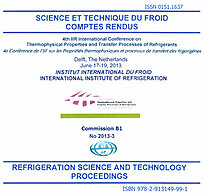
Document IIF
Conception d'un échangeur de chaleur à lit fluidisé pour la production de coulis d'hydrate de CO2.
Design of a fluidized bed heat exchanger for CO2 hydrate slurry production.
Numéro : pap. n. TP-091
Auteurs : ZHOU H., INFANTE FERREIRA C.
Résumé
CO2 hydrate slurry is a newly developed secondary cooling fluid. In order to use CO2 hydrate as a direct coolant of fresh products, a new CO2 hydrate slurry production system (a fluidized bed heat exchanger, FBHE) is under construction and it has been optimized for the expected operating conditions. A sensitivity analysis has been used to identify the optimum design for the specific operating conditions. The model includes the growth of CO2 hydrate on the fluidized bed wall as a function of the operating conditions. The heat of formation is removed by a falling film of evaporating R134a outside the fluidized bed. The maximum capacity of the set-up is 5 kW. The parameters optimized include the internal diameter of the fluidized bed heat exchanger, bed porosity, inert particles inside the FBHE, as well as the refrigerant temperature. Under specific operating conditions: pressure inside the FBHE is 35 bars and solution initial temperature is 6°C, the optimized parameters according to simulation are: internal diameter is 85 mm, bed porosity is 0.7, particle diameter is 5 mm, and refrigerant temperature is 0°C. Under these conditions the apparatus produces 13.2 kg hydrate in one hour.
Documents disponibles
Format PDF
Pages : 9 p.
Disponible
Prix public
20 €
Prix membre*
Gratuit
* meilleur tarif applicable selon le type d'adhésion (voir le détail des avantages des adhésions individuelles et collectives)
Détails
- Titre original : Design of a fluidized bed heat exchanger for CO2 hydrate slurry production.
- Identifiant de la fiche : 30008316
- Langues : Anglais
- Source : 4th IIR Conference on Thermophysical Properties and Transfer Processes of Refrigerants
- Date d'édition : 17/06/2013
Liens
Voir d'autres communications du même compte rendu (69)
Voir le compte rendu de la conférence
-
CO2 hydrate slurry production in a fluidized be...
- Auteurs : ZHOU H., SERA I. de, INFANTE FERREIRA C.
- Date : 16/08/2015
- Langues : Anglais
- Source : Proceedings of the 24th IIR International Congress of Refrigeration: Yokohama, Japan, August 16-22, 2015.
- Formats : PDF
Voir la fiche
-
Heat transfer and flow characteristics during t...
- Auteurs : ZHOU H., INFANTE FERREIRA C. A.
- Date : 02/08/2014
- Langues : Anglais
- Source : 11th IIR Gustav Lorentzen Conference on Natural Refrigerants (GL2014). Proceedings. Hangzhou, China, August 31-September 2, 2014.
- Formats : PDF
Voir la fiche
-
Ice adhesion in the ice slurry production process.
- Auteurs : FRANK S., ÁLVAREZ PARDINAS Á., KIND M., et al.
- Date : 21/08/2011
- Langues : Anglais
- Source : Proceedings of the 23rd IIR International Congress of Refrigeration: Prague, Czech Republic, August 21-26, 2011. Overarching theme: Refrigeration for Sustainable Development.
- Formats : PDF
Voir la fiche
-
Experimental study of semi-clathrate hydrate sl...
- Auteurs : VASILESCU C., INFANTE FERREIRA C.
- Date : 17/06/2013
- Langues : Anglais
- Source : 4th IIR Conference on Thermophysical Properties and Transfer Processes of Refrigerants
- Formats : PDF
Voir la fiche
-
The effect of type-III antifreeze proteins (AFP...
- Auteurs : ZHOU H., INFANTE FERREIRA C.
- Date : 14/07/2014
- Langues : Anglais
- Source : 2014 Purdue Conferences. 15th International Refrigeration and Air-Conditioning Conference at Purdue.
- Formats : PDF
Voir la fiche
